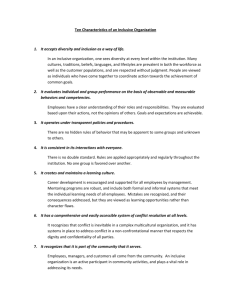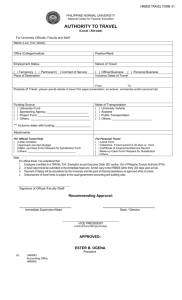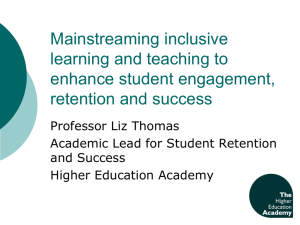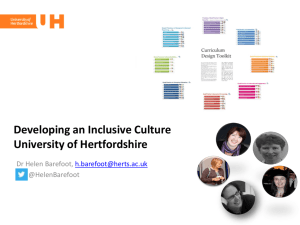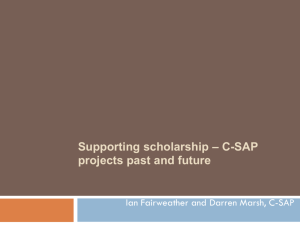Developing an Inclusive Curriculum by Chris Bradshaw
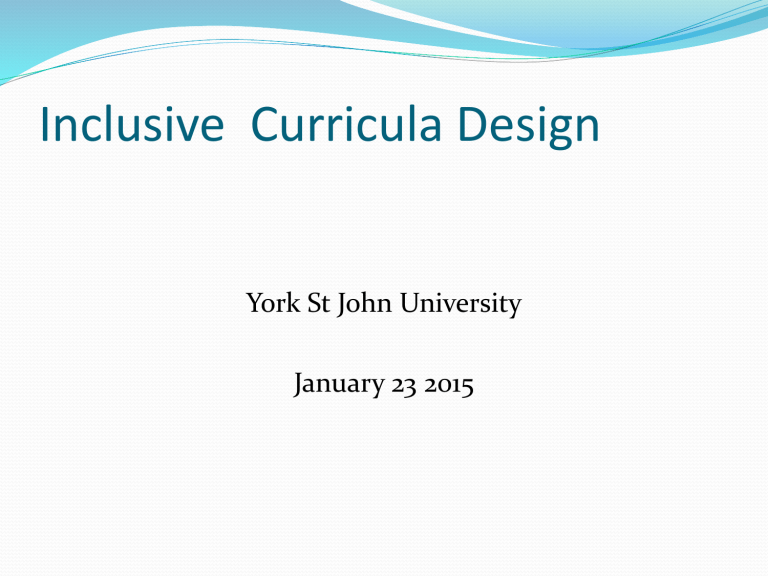
Inclusive Curricula Design
York St John University
January 23 2015
Agenda
Background
The Project
Years 1 & 2- Case Studies and Subject Themes
Year 3 – The Student Voice
General Observations on Inclusion
Questions
Background
Internationalisation of HE
Equality Act 2010
Reasonable adjustments
Promote equality of opportunity
Promote understanding between groups
Scottish Funding Council priority
History
To date many initiatives have looked at diversity in terms of one specific protected characteristic:
Disability
International students
Need to redefine what is meant the inclusive curriculum.
Scottish Funding Council funded project
Curriculum design
Curriculum delivery
Assessment
Some Fundamental Issues
Occupational segregation – staff
Engineering, (some) Science, Education, Computing,
HR
Subject segregation – Students
Engineering, (some) Science, Education, Computing,
HR, Sports (coaching)
Student Retention
Engagement
Pass rates
Students as co-creators
Inclusive Practice
‘Inclusive Curriculum Practice refers to the process of developing, designing and refining programmes of study to minimise the barriers that students may face in accessing the curriculum.’ Gravestock (2008:1)
HEA Change Programme
Developing an Inclusive Culture in HE (4 Scottish HEIs involved)
College Change Programme
8 Colleges Involved
Institutional Case Studies
2 further institutional case studies (1HE & 1FE) to show how change has been carried at the institutional level.
Report available from HEA
Embedding
Equality and
Diversity in the
Curriculum
A three year programme funded by the
SFC and run by the Higher
Education
Academy and
Scotland’s
Colleges.
Years 1 & 2
• Individual Academic
Members of Staff
• Departments / Discipline
Groups
• Institutional Level Work
Individual Academic Members of
Staff
•
•
• Specialist Workshops
Collection of Case Studies (on-going)
Brokerage Service (run by Scotland’s Colleges)
• Capacity Building Workshops / Materials
• Enabling Staff Engagement in the Inclusive Curriculum and
• Using Evidence Based Approaches to Enhance Inclusive
Practice).
• Developing a series of on-line resources
Departments / Discipline Groups
Departments / Discipline Groups
A series of discipline based workshops
Eight areas
Built Environment
Business
Sport
Health and Social Care
Humanities
Beauty and Hairdressing
Business & Management
Computing Science
Students as Co-Creators of
Curricula
Research by Dr Catherine Bovill, Lecturer, Academic
Development Unit, University of Glasgow
Student at University College
Dublin
“You work in a university and you get surrounded by people who should like teaching but who really don’t like teaching and don’t like students…’they’re so stupid’, ‘they don’t do any work’, ‘they’re so lazy’…and I think actually, it’s our problem, because they’re not, they’re smart,
they’re engaged, they’re interested.” (UCD)
The tutor-student relationship
Tutors as gatekeepers to curricula design
Relationship as litmus test to motivations of tutor & students
Students as experts in student experience
Tutors have expert knowledge & control over assessment
Tutor and students as learners in joint inquiry (Freire, 1993)
The importance of the nature of dialogue (Fischer, 2005; Haggis, 2006)
Exposure to rich pedagogical variety - experimentation
Is there a curriculum without students? (Barnett & Coate, 2005)
Tutors operate within the constraints of a market-driven university system (McLean, 2006; Parker, 2003)
Legitimate concerns about handing over control and loss of expertise
How can you teach inclusively?
Be reflective by asking yourself the following:
How might your own cultural-bound assumptions influence your interactions with students?
How might the backgrounds and experiences of your students influence their motivation, engagement, and learning in your classroom?
How can you modify course materials, activities, assignments, and/or exams to be more accessible to all students in your class?
Incorporate diversity into your overall curriculum.
Be intentional about creating a safe learning environment by utilizing ground rules.
Be proactive in connecting with and learning about your students.
Utilize a variety of teaching strategies, activities, and assignments that will accommodate the needs of students with diverse learning styles, abilties, backgrounds, and experiences.
Use universal design principles to create accessible classes. For example, present information both orally and visually.
When possible, provide flexibility in how students demonstrate their knowledge and how you assess student knowledge and development.
Be clear about how students will be evaluated and graded. Provide justifications.
Take time to assess the classroom climate by obtaining mid-semester feedback from students.
Cornell University (2014)
4 Scottish HEIs
Student interviewers in each
Each interviewer doing 40 interviews (10 from each of 4 broad curriculum areas)
160 Voices
Data Collection & Analysis
Student comments
“Yeah definitely different, it’s hard to discriminate against me I’m a young straight white guy, but it does happen to others”
I saw great picture in an Education seminar which had a goldfish, a monkey, and elephant and a bird and they were all asked to go climb that tree. The goldfish is going to suck. You know you have to set a challenge which is achievable but you have to differentiate them for the different people in you class. You should know that especially after you have met them in your seminar. As an education student you should be looking for ways in which you can provide that opportunity to meet the expectation for everyone in that room
What’s been tried?
Curriculum Audits
Self analyses
Institution and Departmental level
Funded research
Student collaboration
Policy
Often linked to learning and teaching strategies
Compliance based approaches
Threat of litigation
The Future
Move away from ‘disability obsession’
Promote academic teachers as owners of inclusive curricula
Institutionalise or departmentalise….not projects
Use subject networks
Spread best practice
Further joint approaches with students
Any questions?
References
Gravestock, P. (2011) Incluisve Curriculum Practices, e-bulletin, University of Gloucestershire / Higher Education
Academy. www.psychology.heacademy.ac.uk/networks/sig/icp.asp
.
Caruana, V. (2011) Promoting students’ ‘resilient thinking’ in diverse higher education learning environments, C-SAP, available at http://www.heacademy.ac.uk/resources/detail/internationalisation/C-SAP_final_report .



